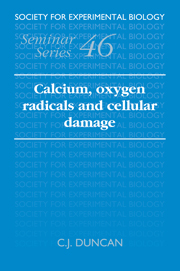Book contents
- Frontmatter
- Contents
- List of Contributors
- Preface
- 1 Are there common biochemical pathways in cell damage and cell death?
- 2 Free radicals in the pathogenesis of tissue damage
- 3 Calcium and signal transduction in oxidative cell damage
- 4 Regulation of neutrophil oxidant production
- 5 Reperfusion arrhythmias: role of oxidant stress
- 6 Biochemical pathways that lead to the release of cytosolic proteins in the perfused rat heart
- 7 Malignant hyperthermia: the roles of free radicals and calcium?
- 8 Free radicals, calcium and damage in dystrophic and normal skeletal muscle
- 9 Ultrastructural changes in mitochondria during rapid damage triggered by calcium
- 10 The importance of oxygen free radicals, iron and calcium in renal ischaemia
- 11 The Rubicon Hypothesis: a quantal framework for understanding the molecular pathway of cell activation and injury
- Index
1 - Are there common biochemical pathways in cell damage and cell death?
Published online by Cambridge University Press: 18 January 2010
- Frontmatter
- Contents
- List of Contributors
- Preface
- 1 Are there common biochemical pathways in cell damage and cell death?
- 2 Free radicals in the pathogenesis of tissue damage
- 3 Calcium and signal transduction in oxidative cell damage
- 4 Regulation of neutrophil oxidant production
- 5 Reperfusion arrhythmias: role of oxidant stress
- 6 Biochemical pathways that lead to the release of cytosolic proteins in the perfused rat heart
- 7 Malignant hyperthermia: the roles of free radicals and calcium?
- 8 Free radicals, calcium and damage in dystrophic and normal skeletal muscle
- 9 Ultrastructural changes in mitochondria during rapid damage triggered by calcium
- 10 The importance of oxygen free radicals, iron and calcium in renal ischaemia
- 11 The Rubicon Hypothesis: a quantal framework for understanding the molecular pathway of cell activation and injury
- Index
Summary
The underlying events during rapid cellular damage have been studied in a variety of cells, particularly kidney, hepatocytes and muscle cells, although the initial lesions are very different, being genetic (e.g. Duchenne muscular dystrophy, see Jackson, McArdle & Edwards, this volume; or malignant hyperthermia, see Arthur & Duthie, this volume), or the response to toxic agents, or the result of endocrine dysfunction or a failure in metabolism. It has been suggested that there may be final common pathways, or that there may be a common central trigger. In particular, Ca2+ has been proposed as having a major role in initiating and regulating these events in cell death and toxic cell killing (Duncan, 1978; Schanne et al., 1979; Farber, 1981; Trump, Berezesky & Osornio- Vargas, 1981; Nayler, 1983; Orrenius et al., 1989) and consequently these studies have concentrated on the ways in which the initial lesion may result in changes in the intracellular concentration of free Ca2+ ([Ca2+]i) and on the pathways that may be activated by a rise in [Ca2+]i. For example, the missing gene product (dystrophin) in Duchenne muscular dystrophy and in mdx mice has been identified as a sub-sarcolemma cytoskeletal protein and it remains to be explained how its absence leads to the rise in [Ca2+]i that has been measured, and to the breakdown of the sarcolemma myofilament apparatus (see Duncan, 1989a). There is little doubt that a rise in [Ca2+]i can precipitate rapid cell damage; it can be produced experimentally by exposure of cells to the divalent cation ionophore A23187 and an elevated [Ca2+]i has been measured in such conditions as malignant hyperthermia (Lopez et al., 1985).
- Type
- Chapter
- Information
- Calcium, Oxygen Radicals and Cellular Damage , pp. 1 - 10Publisher: Cambridge University PressPrint publication year: 1991
- 1
- Cited by



